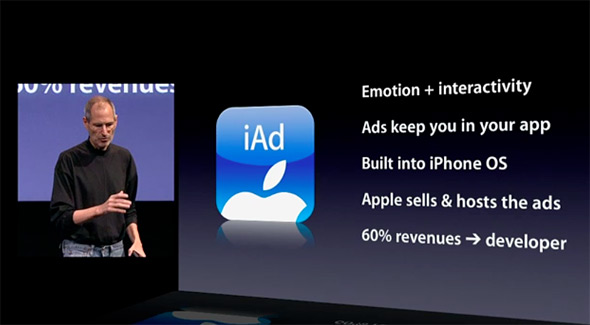When Apple announced their iAd advertising platform yesterday, it’s possible many excited iPhone users yawned a bit. What was this going to change? Well, the answer to that question is: a lot.
Jobs himself explained why: right now, mobile advertising sucks. You either see a tiny text ad that gives very little information, or you see a large ad in an app that, once you click on it, takes you out of the application and into the browser, ruining the seamlessness of your experience.
Worse, because ads are so terrible, the mobile market remains both massive and untapped; there are tens of millions of people using web-enabled smartphones, but little ad-generated profit is being made. In an era where media companies are scrambling for new revenue streams, this is obviously less than ideal.
iAd solves this dilemma by allowing app makers to take rich, full-featured ads that include video and interactivity and bake them right into their apps. Rather than moving away from their applications – which discourages people from clicking on ads at all – users will now simply look at or interact with ads and jump back to their app at their convenience.
What’s more, by basing the the ad system on HTML5 and working through Apple’s central iAd servers, advertisers can create fully interactive programs like mini-games or have users watch video.
By allowing advertisers to have such control and deep experiences, Apple has essentially produced a new mobile advertising ecosystem. And if Apple’s prediction of a billion ad impressions a day is even close to true, then we’re talking a lot of cash and a lot of clout for the Cupertino wizards.
That’s not to say that iAd doesn’t already have its detractors. Google, who make the bulk of their profit by placing ads next to search terms, are understandably worried and have already come out against the idea. Meanwhile, Adobe are baffled that Apple seems out to entirely kill its Flash business; most ad houses work in Flash, and a much advertised feature of Flash CS5 was the ability for App Store app makers to transfer their flash software into iPhone apps. None of this is to mention that as consumers, we should always be wary when companies try to get us to spend a good part of our day ‘interacting’ with advertising.
But for Apple, and anyone who uses the apps and the mobile web, this is huge, and will fundamentally redraw the dynamics of revenue and development in the mobile market. In a sense, Apple are becoming to mobile advertising what Google are to desktop search. And any way you spin it, that is a big deal.
[Source: Ads of the World]





